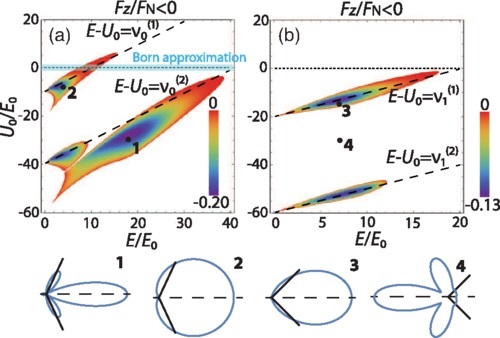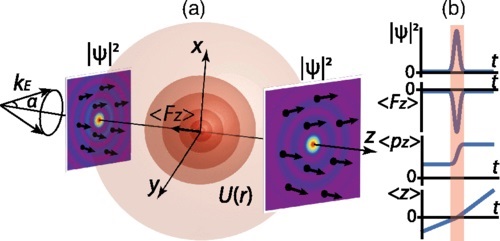5 June 2017
Tractor beams first became a topic of conversation two centuries ago in science fiction: the term implied a beam of light that could lift and move various objects. It is commonly associated with aliens pulling objects from Earth aboard their flying saucers. An idea that seemed improbable some decades ago has become real: scientists all over the world are coming up with ways of moving objects. Although, for now, these “tractor beams” can only move nanoparticles. An international research group that includes a scientist from ITMO University has contributed to this field of study: they have proven that de Broglie waves (probability waves), which in quantum mechanics denote a matter wave, are also capable of displaying the properties of a tractor beam.


Current research on tractor beams
In 2011 physicists from two different research teams proved that microscopic objects can be moved in a direction opposite to that of a Bessel beam laser. Due to a Bessel beam’s unique qualities, quanta of light (photons) can diffuse primarily forward – in the direction of the beam itself. Thus photons inflict force on an object, a force that is directed inwards to the beam. In other words, the object is “drawn” to the source of the beam. The equipment needed to conduct such experiments needs to be adjusted very precisely, which is why later on other research teams began using two or more Bessel beams in their tests.
Turns out a tractor beam can be implemented not only using light. In 2014 scientists from the Australian National University and the University of Pennsylvania succeeded in making objects placed on the surface of water move in a direction opposite to that of a wave. This was achieved using a special device that generated 3D-waves that create mini-whirlwinds on the surface. These whirlwinds can capture an object and make it move toward the source of the waves. It can also hold an object in place or push it away.
In that same year the same Australian-American team successfully manipulated an objectwith a diameter of 0.2 mm using a laser beam placed 20 cm away. For that purpose, the scientists heated the surface around the object. By manipulating the heat points through reversing the laser’s polarity, researchers were able to move the object in any direction. They also claimed that the technology can work on any distance due to the laser beam’s low divergence.
In 2015 a British research team published their findings on the creation of acoustic tractor waves. The possibility for manipulating objects through sound waves has been discovered earlier, but this project suggests using a single acoustic emitter. The scientists used 64 micro-loudspeakers that created high-pitch, high-intensity ultrasound waves. By changing the output of the loudspeakers, they managed to move and rotate a bead 4 mm in diameter.
It should be noted that a scientific team from ITMO University has, too, contributed to the current development of optical pulling force technology: in 2016 they studied the pulling force that affected a nanoparticle near a plasmonic interface; the pulling force in their experiment resulted from excitation of surface waves on the plasmonic interface.
International scientific team’s research on tractor beams
The scientists have proven that de Broglie waves (probability waves) possess similar “pulling” properties. In quantum mechanics, where probability waves denote a matter wave, it is accepted that any particle possesses wave properties. A major example of wave properties of matter is Richard Feynman’s famous double-slit thought-experiment that has recently been tested in a real-life experiment.
The scientific team that discovered the “pulling” properties of such waves includes: Alexey Gorlach, student at Belarusian State University, Maxim Gorlach, scientist at ITMO University’s Department of Nanophotonics and Metamaterials, Andrey Lavrinenko, Associate Professor at Technical University of Denmark (DTU) and Andrey Novitsky, Senior Researcher at DTU. The team has analyzed the influence of several of the probability wave’s parameters on its “pulling” properties; they also analyzed the specifics of such an interaction between a beam and a controlled object. The team has found that there is a wide parameter range in which it can pull objects towards its source.
“For a beam to attract a particle, the Bessel beam needs to have the correct parameters (divergence angle of 600 and higher), while the particles in it need to be sufficiently slow, their kinetic energy amounting to from a few thousandths of an electron-volt (eV) to several eV. Such a pulling beam theoretically allows us to manipulate atoms weighing anywhere from several atomic mass units (AMU) to hundreds of AMU. Unlike optical pulling beams, probability waves can manipulate even smaller objects. Previous research has proven that pulling force is possible in waves of many natures: from acoustic to electromagnetic. But as we know from quantum mechanics, matter is a wave, too. Therefore, we can expect pulling force to be present in probability waves, too. Of course, to prove this, we had to perform the calculations, figure out the conditions in which pulling force emerges and measure the order of magnitude,”
– comments Alexey Gorlach.
Yet the article’s authors emphasize that the waves’ probabilistic nature does not affect their ability to attract objects. Due to probability waves’ capability of acting as both particles and waves, classic laws of physics regarding particles and waves do not apply to them. Quantum physics state that such a particle (or wave) can’t be described in terms of trajectory, but can be described as being in a given volume of space with a certain probability. So how did the scientists figure out how to control a wave to pull objects?
“The values that can be seen in the real experiment (including the pulling force applied by the beam to the test object) represent, from a theoretical point of view, the average values of quantum-mechanical operators. These averages are unambiguous, which allows us to speak of pulling or repelling forces. This can be illustrated by a simple example: when we measure the lighting level in a room, what we really measure is the average value of an electric field. Yet our device does not register the fact that this field is oscillating in a given point at a frequency of hundreds of terahertz,”
– explains Maxim Gorlach.
The idea of using probability waves to manipulate nanoobjects proposed by the authors could be used in future to control atoms and atomic clusters with precision that is multitudes higher than that of optical tweezers. The authors’ research was published in the renowned physics journal Physical Review Letters; it has already attracted the attention of the scientific community and was featured by the journal’s editorial staff in categories “Editor’s Suggestion” and “Featured in Physics”.
Reference: Alexey A. Gorlach, Maxim A. Gorlach, Andrei V. Lavrinenko, and Andrey Novitsky (2017), Matter-Wave Tractor Beams, Physical Review Letters.
https://journals.aps.org/prl/abstract/10.1103/PhysRevLett.118.180401















